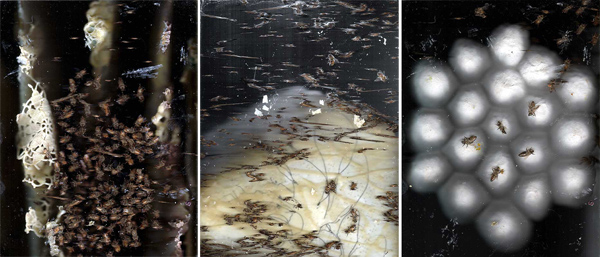Aganetha Dyck @ McIntosh Gallery

Aganetha Dyck is included in the McIntosh Gallery’s current exhibition “Insect As Idea”
Carl Beam, Christi Belcourt, Catherine Chalmers, Andrea Cooper, Aganetha and Richard Dyck, Jude Griebel, The Institute of Queer Ecology, Jennifer Murphy and Amy Youngs
Featuring insect specimens from the Zoological Collections, Department of Biology, Western University
April 28 – June 18, 2022
Curated by Dr. Helen Gregory and Dr. Nina Zitani
From the imperceptible flutter of a butterfly wing to the electric buzzsaw whine of summer cicadas, the thrum of insects forms a subtle soundtrack to our quotidian existence. Insects have captured human imagination for centuries. The ancient Greeks equated butterflies with the soul to such an extent that they used the same word – psyche – to refer to both. Aristotle devoted considerable attention to the study of natural history and was especially fascinated by the complete metamorphosis of insects. He regarded the transformation as a means by which an imperfect animal could attain the condition of perfection, which he associated with the notion of telos, meaning full potential or inherent purpose.
Insect as Idea examines insects within a multispecies framework, considering the role that they play throughout ecological systems. How have we learned from insects in the past and what can they tell us about the future? If we read insects as bellwethers or even, more poetically, as ideas made manifest, what does their disappearance say about human-earth relationships? This exhibition puts the work of artists Carl Beam, Christi Belcourt, Catherine Chalmers, Andrea Cooper, Richard and Aganetha Dyck, Jude Griebel, The Institute of Queer Ecology, Jennifer Murphy and Amy Youngs in conversation with the exquisitely beautiful historical collection of Riker Mounts housed in the Zoological Collections at Western University. Many of the specimens housed in the Zoological Collections were collected in the early twentieth century by former professors and scientists as part of their research projects. Other specimens were collected by local hobby naturalists and later donated to Western, including a collection of Riker mounts on display here. Such historical collections have roots in the history of colonialism and are characterized by the impulse to exhibit dominance over nature through the collection and display of rare species. Today, however, they collectively serve a new role in documenting past species occurrences allowing scientists to track changes in biodiversity locally and globally. They are also an important educational tool, allowing students to see real specimens of insect biodiversity from North America to the Amazon Rainforest, Africa, India, Southeast Asia and other localities around the globe.
Each of the artists in this exhibition considers insects within a multispecies ecology or cultural history. In a work from The Columbus Project, Carl Beam juxtaposes images of bees with a portrait of Christopher Columbus, addressing the historically imbricated impulses of exploration, discovery and colonization, with analysis and classification. Christi Belcourt intertwines bees, birds, strawberries, and other native plants to underscore the interconnectedness of living things within the natural world. Catherine Chalmers presents a series of extraordinary films, drawing parallels between the behaviour of neo-tropical leafcutter ant colonies and the human traits of language, ritual, war, and art, with the aim of blurring the lines between culture and nature. Originally created for Instagram, Andrea Cooper’s film Wild Honey provides a metaphorical exploration of fertility, colony collapse disorder, and climate change. Aganetha and Richard Dyck work collaboratively with bees to co-create works of art, in this instance through the use of a flatbed scanner inserted into a beehive. New work from Jude Griebel takes inspiration from Victorian anthropomorphic illustration to imagine a tiny entomological protest against the current ecological crisis. The Institute of Queer Ecology’s three-part film Metamorphosis is a call to reimagine and rebuild the planet, employing the metaphor of the life-cycle of an insect in which the organism fully restructures itself to adapt to its changing needs and ensure its survival. Jennifer Murphy combines images culled from old nature books to create composite forms that remind us of the complexity of ecological relationships. Amy Youngs “shakes hands” with a cluster of composting worms in an interspecies gesture of respect that acknowledges our dependence on the organisms that decompose our waste. Collectively, the work encourages us to consider the importance of monitoring insect biodiversity as an indicator of the health of an ecosystem, be it thriving or imperilled.
Insect as Idea Panel Discussion
Thursday, May 12 at 5:30 p.m. EST on Zoom
Registration required
Join us for a panel discussion hosted on Zoom in partnership with the Zoological Collections, Department of Biology, Western University, on Thursday May 12. In conversation with exhibition curators Dr. Helen Gregory and Dr. Nina Zitani, participating artists Catherine Chalmers, Andrea Cooper, Aganetha Dyck, Jude Griebel, and Amy Youngs will discuss how their practices have been influenced by environmental issues and multi-species ecologies.
Register to attend HERE